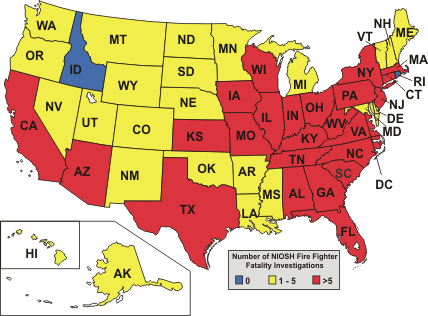|
Each year an average of 105 fire fighters die in the line of duty. To
address this continuing national occupational fatality problem, NIOSH
conducts independent investigations of fire fighter line of duty deaths.
This web page provides access to NIOSH investigation reports and other
fire fighter safety resources.
Fatality Investigation Reports
To list all investigative reports completed for a particular state, click
on the map.

The drop down boxes below allow for interactive queries
of completed investigative reports. Select a state, incident year and/or
Medical or Trauma Category from the selection boxes and click on Submit.
(Note: subcategories for the Medical-Related Reports will be added at
a later date.)
Recently Released Reports
Fire Fighter Fatality Investigation # F2008-10 Volunteer Fire Fighter Dies in a Tanker Crash – Louisiana (added 9/08/08)
Fire Fighter Fatality Investigation # F2007-36 Fire Chief Suffers Sudden Cardiac Death After Strenuous Training Drill – New York (added 8/06/08)
Fire Fighter Fatality Investigation # F2007-21 Fire Fighter-Emergency Medical Technician Suffers Sudden Cardiac Death During Physical Fitness Training – Nevada
(added 8/06/08)
Fire Fighter Fatality Investigation # F2007-22 After Working Three Consecutive 24-Hour Shifts and Fighting an Extensive Structure, a 47-Year Old Career LT Suffers Sudden Cardiac Death During Physical Fitness Training – California (added 7/31/08)
Fire Fighter Fatality Investigation # F2007-20 Engineer Suffers Sudden Cardiac Death After Responding to Three Emergency Calls and Performing Physical Fitness Training – Arizona (added 7/29/08)
Recent NIOSH
Fire Fighter Safety Publications
Preventing Fire Fighter Fatalities Due to Heart Attacks and Other Sudden Cardiovascular Events
DHHS (NIOSH) Publication No. 2007-133
Fire fighters are at risk of dying on the job from preventable cardiovascular conditions.
FDA AND NIOSH Public Health Notification: Oxygen Regulator Fires Resulting from Incorrect Use of CGA 870 Seals
External link: http://www.fda.gov/cdrh/safety/042406-o2fires.html
This document provides information on the danger of fires at the interface of oxygen regulators and cylinder valves because of incorrect use of CGA 870 seals, and identifies measures to prevent such fires.
NIOSH Alert: Preventing
Injuries and Deaths of Fire Fighters due to Truss System Failures
DHHS (NIOSH) Publication No. 2005-132
Fire fighters may be injured and killed when fire-damaged roof and floor
truss systems collapse, sometimes without warning.
NIOSH
Workplace Solutions—Preventing Deaths and Injuries to Fire Fighters
During Live-Fire Training in Acquired Structures
DHHS (NIOSH) Publication No. 2005-102
Fire fighters are subjected to many hazards when participating in live-fire
training. Training facilities with approved burn buildings should be used
for live-fire training whenever possible. However, when acquired structures
are used for live-fire training, NIOSH strongly recommends that fire departments
follow the national consensus guidelines in NFPA 1403, standard on live-fire
training evolutions [NFPA 2002a] to reduce the risk of injury and death.
These guidelines are summarized in the recommendations in this document.
Radio Communication
Current Status, Knowledge Gaps, and Research
Needs Pertaining to Firefighter Radio Communication Systems
The National Institute for Occupational Safety and Health (NIOSH) commissioned
this study to identify and address specific deficiencies in firefighter
radio communications and to identify technologies that may address these
deficiencies. Specifically to be addressed were current and emerging technologies
that improve, or hold promise to improve, firefighter radio communications
and provide firefighter location in structures.
The National Institute of Standards and Technology, Building and Fire Research Laboratory publication "Testing of Portable Radios in a Fire Fighting Environment"  265 KB (24 pages) 265 KB (24 pages)
External link: http://fire.nist.gov/bfrlpubs/fire06/PDF/f06015.pdf focuses on the thermal environment that radios would be expected to withstand while being used in structural fire fighting operations. Current NFPA standards for radios are reviewed and recommendations for establishing performance standards are presented. The need for providing additional protection from the thermal environment is documented.
Page last updated:
September 8, 2008
Page last reviewed:
April 8, 2008
Content Source: National Institute for Occupational Safety and Health (NIOSH)
|


